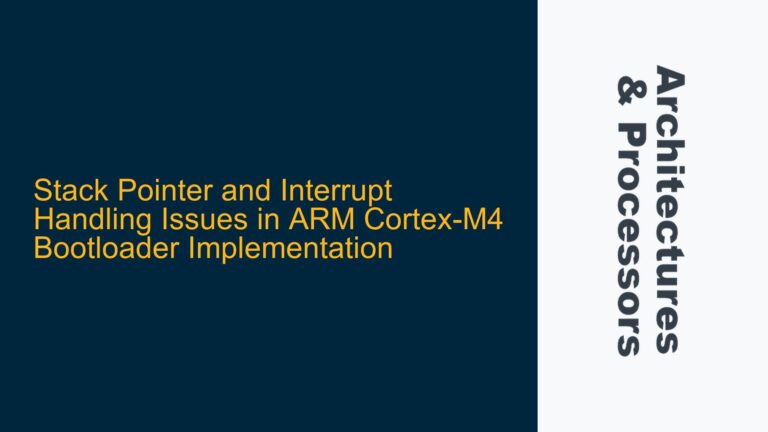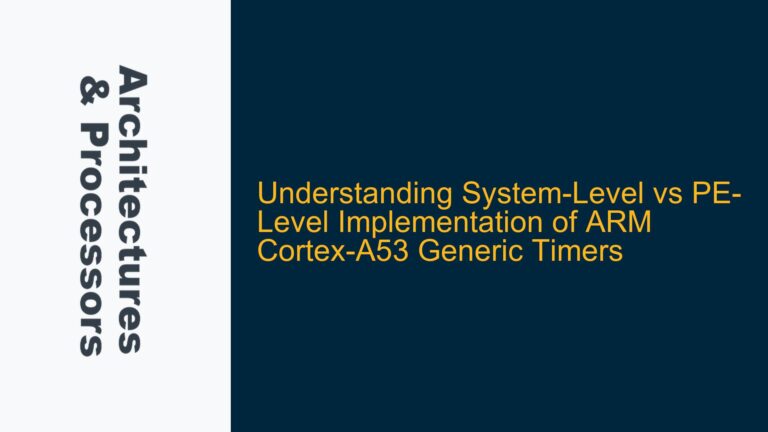ARM Cortex-M4F FPU Limitations and Double-Precision Floating-Point Overhead
The ARM Cortex-M4F microcontroller, part of the Armv7E-M architecture, is equipped with a single-precision Floating-Point Unit (FPU) that natively supports 32-bit floating-point operations. This FPU is optimized for single-precision arithmetic, enabling efficient computation of 32-bit floating-point values. However, when double-precision (64-bit) floating-point operations are required, the Cortex-M4F must rely on software-based libraries to perform these calculations, as its FPU lacks native support for double-precision arithmetic. This reliance on software libraries significantly increases the ROM footprint of the application.
The primary reason for this increased ROM consumption is the need for additional instructions and routines to handle double-precision arithmetic. Single-precision floating-point operations can be executed directly by the FPU using dedicated instructions such as vadd.f32 for addition. In contrast, double-precision operations require multiple steps, including loading and storing 64-bit values, splitting them into 32-bit registers, and performing arithmetic operations using software routines. These routines are often provided by the compiler’s runtime library, such as __adddf3 for double-precision addition, which consumes additional ROM space.
Furthermore, the Cortex-M4F’s FPU is designed to operate on 32-bit values, meaning that double-precision operations cannot leverage the hardware acceleration provided by the FPU. This results in a performance penalty, as double-precision arithmetic is significantly slower than single-precision arithmetic on this architecture. The combination of increased ROM usage and reduced performance makes double-precision floating-point operations less efficient on the Cortex-M4F compared to single-precision operations.
Memory Access Patterns and Software-Based Double-Precision Arithmetic
The increased ROM consumption associated with double-precision floating-point operations on the ARM Cortex-M4F can also be attributed to the memory access patterns and the complexity of software-based arithmetic routines. Double-precision values occupy 64 bits of memory, requiring two 32-bit registers or memory locations to store a single value. This necessitates additional load and store operations, as well as more complex data handling compared to single-precision values.
For example, consider the assembly code provided in the discussion. Single-precision floating-point addition is performed using a single instruction (vadd.f32), which directly operates on 32-bit values stored in the FPU’s registers. In contrast, double-precision addition requires loading the 64-bit values into general-purpose registers using ldrd instructions, calling a software routine (__adddf3), and then storing the result back to memory using strd. This process involves multiple instructions and function calls, each of which contributes to the increased ROM footprint.
Additionally, the software routines for double-precision arithmetic must handle edge cases, such as denormal numbers, infinity, and NaN (Not a Number), which further increases their complexity and size. These routines are typically included in the compiler’s runtime library and are linked into the application when double-precision arithmetic is used. As a result, even a small number of double-precision operations can lead to a significant increase in ROM usage due to the inclusion of these routines.
Optimizing ROM Usage and Performance for Floating-Point Operations on Cortex-M4F
To mitigate the increased ROM consumption and performance overhead associated with double-precision floating-point operations on the ARM Cortex-M4F, developers can employ several strategies. First, it is essential to evaluate whether double-precision arithmetic is truly necessary for the application. In many cases, single-precision floating-point arithmetic provides sufficient precision, and switching to single-precision can significantly reduce ROM usage and improve performance.
If double-precision arithmetic is required, developers should consider optimizing the code to minimize the number of double-precision operations. This can be achieved by using mixed-precision arithmetic, where only critical calculations are performed using double-precision, while the majority of the computation is done using single-precision. This approach reduces the reliance on software-based double-precision routines and can help balance precision requirements with ROM and performance constraints.
Another optimization technique is to use compiler flags and settings that control the inclusion of floating-point libraries. For example, some compilers allow developers to specify whether double-precision arithmetic should be handled using software routines or if the FPU should be used to accelerate certain operations. While the Cortex-M4F FPU does not natively support double-precision arithmetic, some compilers may provide optimizations that reduce the overhead of double-precision operations.
Finally, developers should carefully analyze the memory layout and access patterns of their application to ensure efficient use of ROM and RAM. This includes minimizing the number of load and store operations for double-precision values, aligning data structures to reduce memory fragmentation, and using appropriate data types to avoid unnecessary conversions between single-precision and double-precision formats.
In conclusion, the increased ROM consumption observed when using double-precision floating-point operations on the ARM Cortex-M4F is primarily due to the lack of native hardware support for double-precision arithmetic. This necessitates the use of software-based routines, which consume additional ROM space and incur a performance penalty. By understanding the limitations of the Cortex-M4F FPU and employing optimization strategies, developers can effectively manage ROM usage and performance while meeting the precision requirements of their applications.






